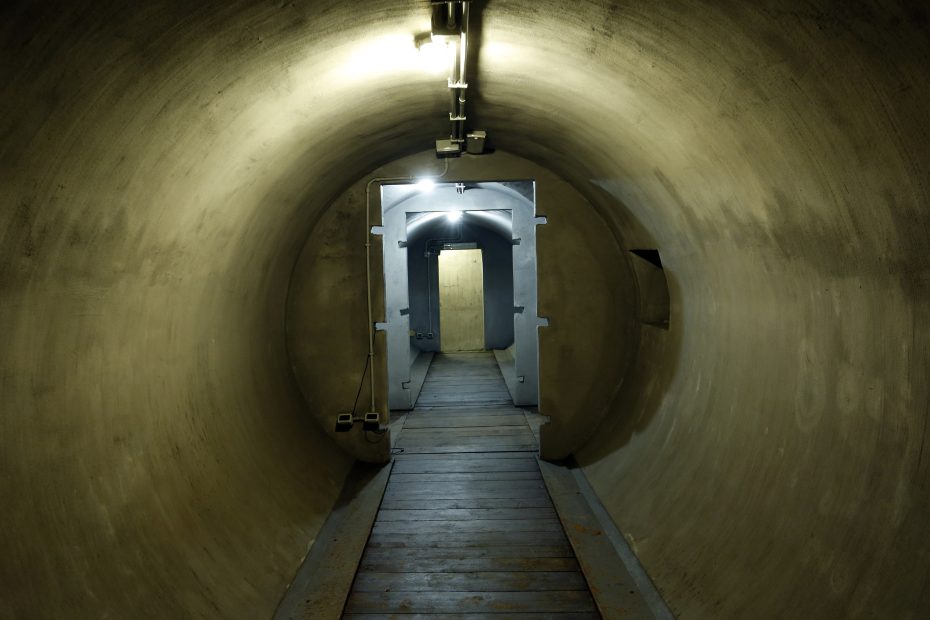Six meters below a Roman palace lies an underground bunker built to protect Italian fascist dictator Benito Mussolini.
The double steel gas doors of a piece of 84-year-old history are once again open to the public.
Three bunkers were built in the sprawling 19th-century Villa Torlonia, Mussolini’s private residence in Rome between 1925 and 1943, when he ruled Italy with brutal control.
The house, built to be a palace, has a casino, several lakes, a tennis court. courthorse stables and multiple homes.
In 1940, Italy entered World War II and work immediately began to build the first underground shelter to protect Mussolini and his family from wartime bombing.
The first was an old winery converted in the garden under a small lake, located about 150 m from the house.
To prevent the family from having to run to safety, a second bunker was built by enveloping an underground kitchen with reinforced concrete.
In some parts it was four meters thick and had anti-gas doors and an air purification system.
However, as the war progressed, Allied forces closed in and bombed. bells A third armored bunker was planned.
Located outside the Noble Casino building, it was six meters deep, 15 meters wide and built in the shape of a cross.
Construction began in 1942, but Mussolini is said to have written complaints that it was late and overcosted.
It was incomplete when arrested in 1943.
Who was Benito Mussolini?
Born on July 29, 1883, Benito Mussolini was the leader of the country’s National Fascist Party.
Known as “Il Duce” (The Leader), he became Prime Minister in 1922, quickly consolidated his power until he became dictator in 1925 and ruled until 1943.
Following the Abyssinian crisis of 1935-36, he invaded Ethiopia, which was widely condemned by Western powers, but gained the backing of German leader Adolf Hitler.
Hitler and Mussolini formed what was called the Rome-Berlin Axis and signed a cooperation treaty.
On June 10, 1940, Italy entered World War II, on the side of Germany, and passed racial laws under which thousands of Jews were persecuted.
In October of that year, Mussolini sent Italian forces to Greece, although he was unsuccessful and the counteroffensive drove the forces back to Albania.
Italy also suffered a humiliating defeat when it joined with Germany to launch an attack on the Soviet Union.
Mussolini also suffered defeat when the Axis powers were crushed in North Africa.
In July 1942, the Grand Council of Fascism approved a motion of censure against Mussolini and on July 25 the king dismissed him as head of government.
He was detained until he was rescued by German troops.
When Allied bombing raids hit Rome in July 1943, the dictator was under Nazi protection and leading a puppet state in northern Italy.
Mussolini then attempted to flee the country with his lover Clara Petacci to Switzerland, but they were both captured by communist partisans and executed by firing squad.
His body was then taken to Milan and hung upside down at a gas station to publicly confirm his death.
He was later killed while fleeing Allied forces in April 1945, and his body was hung by his feet for public viewing in Milan.
Inside the bunker system are armored doors, stairs leading to emergency exits, rusty anti-gas contraptions, works of art, and secret passages.
The label on one air purifier bore the date November 1940 in Roman numerals, in keeping with Mussolini’s style of evoking the glory days of the ancient Roman empire as inspiration for his own government.
Marco Placidi, president of the non-profit organization Underground Rome, said: “With the fall of fascism it was never completely completed, so today we can see it as it was left after Mussolini’s arrest.”
If completed, it would have been the strongest air raid shelter in Italy dedicated to one family.
The bunker and the rest of Mussolini’s luxurious villa and gardens were first opened to tourists in 2006, but closed two years later.
It opened again in 2014 with more parts to explore after they were found under a secret wooden door.
At the time, Rome’s culture department said it hoped it would remind locals and tourists alike of “one of the darkest pages of our history.”
Today, Villa Torlonia is a park full of pine and palm trees where Romans run, walk, play soccer or dine in an open-air restaurant.
Last October, Italian lawmakers backed a long-delayed project to build a Holocaust museum in parts of Mussolini’s Villa Torlonia.
It languished for years due to bureaucratic obstacles, but also what critics see as a reluctance to examine the role of Italy’s fascist regime in authoring the Holocaust.












